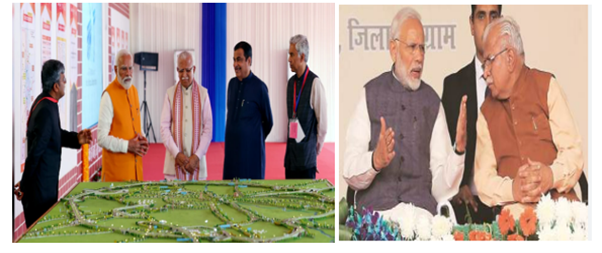India, a country of over 1.4 billion people, is undergoing a profound transformation. As the country races towards becoming a developed nation by 2047, the foundational pillars of growth—electricity and urban development—are receiving long-overdue attention. Two significant thrusts driving this transformation are the National Mission for 24×7 Electricity for All and an urban reform agenda grounded in participatory governance and digital transparency. These twin engines are not only lighting up homes and energizing industries but also reshaping the fabric of Indian cities to be more inclusive, resilient, and future-ready.
Quiet Revolution in Power and Urban Affairs
In the realm of governance, some leaders stand out not by noise but by the quiet strength of reform. Manohar Lal Khattar, known chiefly as the former Chief Minister of Haryana, made significant yet under-recognized contributions during his tenure in the Union Ministries of Power and Urban Development. While his central stint was overshadowed by his state leadership, Khattar’s methodical and impact-driven approach left a legacy of practical transformation. India’s progress in energy and urban governance owes much to such silent reformers.
As a minister in the Ministry of Power, Khattar aligned himself with India’s mission of “24×7 Power for All.” He focused on reducing transmission losses, pushing for smart metering, and promoting renewable energy adoption. His administrative push helped many DISCOMs move toward financial discipline and efficiency.
In urban development, Khattar championed citizen-centric governance under the AMRUT and Smart Cities Mission. He emphasized transparent municipal functioning, digital service delivery, and integrated urban planning. His leadership helped bring piped water, better sanitation, and modern infrastructure to smaller cities and towns—truly empowering India’s urban backbone.
Powering India with Stability and Vision
The Mission: 24×7 Electricity for All
Launched with the intent to ensure uninterrupted electricity supply to every household, commercial establishment, and industrial unit, the mission to provide 24×7 power for all is among the most ambitious developmental goals undertaken in post-liberalization India. It is not just about energy access; it is about economic empowerment, educational progress, and digital inclusion.
The Role of DISCOMs and State Coordination
At the heart of the power distribution ecosystem lie the Distribution Companies (DISCOMs), whose health and efficiency determine the success of the entire grid. Recognizing this, the government initiated extensive structural reforms focusing on:
- Rational Tariff Structures: States were encouraged to rationalize tariffs to reflect the true cost of supply while protecting vulnerable consumers through targeted subsidies.
- Reduction in T&D Losses: Technical and commercial losses, once peaking at nearly 30% in many states, have been brought down significantly through better infrastructure, vigilance, and advanced technologies.
- State-Level Coordination: A cooperative federalism approach was adopted, enabling state-specific plans and performance-based funding, thereby tailoring reforms to local conditions.
Embracing a Digital-First Power Sector
Technology has played a transformative role in India’s power revolution. Key interventions include:
- Smart Metering: The deployment of smart meters has reduced manual errors, ensured real-time data capture, and enabled prepaid systems that benefit both consumers and providers.
- Digital Billing Systems: Seamless digital interfaces have led to increased collections, reduced disputes, and promoted paperless governance.
- Remote Monitoring: Grid operations, fault detection, and load forecasting have become more efficient through AI-driven monitoring systems.
Renewable Energy Integration
India’s energy future is green. As part of the global commitment under the Paris Agreement, the mission aligns with India’s renewable energy ambitions. The integration of solar, wind, and hybrid systems into the national grid has been expedited through regulatory reforms and incentivized private participation.
Urban Reforms with a People-First Focus
Transparent Urban Governance
Urban India is no longer just about megacities. The government has reimagined governance in second- and third-tier cities, with a focus on:
- E-Governance Platforms: Municipal services including birth certificates, water tax, building approvals, and grievance redressal are increasingly digitized.
- Public Dashboards: Real-time monitoring of urban projects is accessible to citizens, enhancing accountability and trust.
- Citizen Feedback Mechanisms: Apps and platforms like MyGov and Swachh Bharat have democratized urban planning by integrating citizen feedback into policy decisions.
Converged Development: Housing, Transport, Sanitation
Recognizing the interconnected nature of urban challenges, the government has moved towards a holistic development model:
- Pradhan Mantri Awas Yojana – Urban (PMAY-U): With a vision of “Housing for All,” the scheme has provided millions of urban poor with dignified living spaces.
- Urban Transport Reforms: Integration of metro systems, public buses, and non-motorized transport has enhanced mobility while reducing emissions.
- Swachh Bharat Mission (Urban): By focusing on toilet construction, waste management, and public awareness, urban sanitation has seen a quantum leap.
Equity and Inclusion at the CoreUrban development has also focused on social equity:
- In-Situ Slum Redevelopment: Ensures that the urban poor are not displaced but integrated into formal city structures.
- Women-Centric Facilities: Safety audits, women-only transport, and self-help groups have been encouraged to empower women in urban settings.
- Skill Development: Linking urban employment programs with skilling initiatives to create sustainable livelihoods.
Conclusion: A Future Lit and Lifted by Reform
India’s journey toward 24×7 electricity and people-first urban reforms is not merely a policy narrative; it is a story of transformation that touches every Indian home and community. These reforms, marked by accountability, inclusivity, and digital empowerment, reflect a vision where development is not a privilege but a right. As India looks ahead to its centenary of independence, it does so with the confidence that its power grids and city plans are not just operational, but inspirational.
(The views expressed are the author's own and do not necessarily reflect the position of the organisation)


